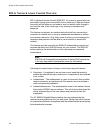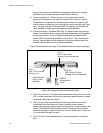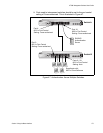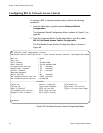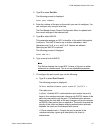AT-S84 Management Software User’s Guide
Section I: Using the Menus Interface 169
Authentication
Process
Below is a brief overview of the authentication process that occurs
between a supplicant, authenticator, and authentication server. For further
details, refer to the IEEE 802.1x standard.
Either the authenticator (that is, a switch port) or the supplicant can
initiate an authentication prompt exchange. The switch initiates an
exchange when it detects a change in the status of a port (such as
when the port transitions from no link to valid link), or if it receives a
packet on the port with a source MAC address not in the MAC address
table.
An authenticator starts the exchange by sending an EAP-Request/
Identity packet. A supplicant starts the exchange with an EAPOL-Start
packet, to which the authenticator responds with a EAP-Request/
Identity packet.
The supplicant responds with an EAP-Response/Identity packet to the
authentication server via the authenticator.
The authentication server responds with an EAP-Request packet to
the supplicant via the authenticator.
The supplicant responds with an EAP-Response/MDS packet
containing a username and password.
The authentication server sends either an EAP-Success packet or
EAP-Reject packet to the supplicant.
Upon successful authorization of the supplicant by the authentication
server, the switch adds the supplicant’s MAC address to the MAC
address as an authorized address and begins forwarding network
traffic to and from the port.
When the supplicant sends an EAPOL-Logoff prompt, the switch
removes the supplicant’s MAC address from the MAC address table,
preventing the supplicant from sending or receiving any further traffic
from the port.
Authenticator
Ports
All of the ports on the AT-9000/24 Gigabit Ethernet switch are
authenticator ports. An authenticator port can have one of three settings.
These settings are referred to as the port control settings. The settings
are:
Auto - Activates 802.1x authentication. An authenticator port with this
setting does not forward network traffic to or from the end node until
the client has entered a username and password that the
authentication server must validate. The port begins in the
unauthorized state, sending and receiving only EAPOL frames. All
other frames, including multicast and broadcast frames, are discarded.
The authentication process begins when the link state of the port
changes or the port receives an EAPOL-Start packet from a supplicant.
The switch requests the identity of the client and begins relaying
authentication prompts between the client and the authentication










